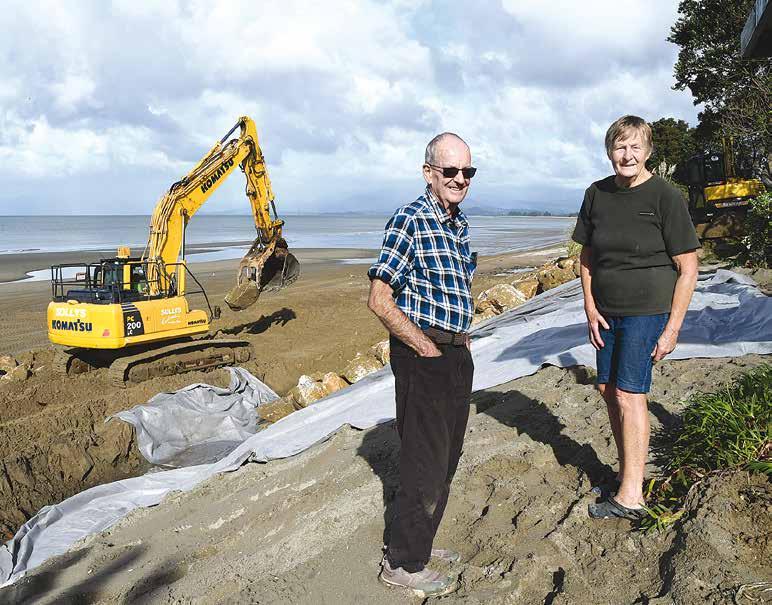
3 minute read
Seawall to protect homes
The Waimea Dam project has reached a major milestone. At 4pm last Friday the dam’s main culvert was closed allowing the reservoir to fill. When it reaches design capacity, the artificial lake will hold around 13 million cubic metres of water.
The watershed moment comes after four years of construction, which at times has been dogged by covid lockdowns, supply-chain issues, escalating material costs and significant geological issues. A series of cost overruns has taken the current estimate to completion to $198.2 million, almost twice the figure quoted at the time the project was green-lit.
Advertisement
The closure of the reservoir had been postponed by the contractor’s delay in supplying the requisite quality assurance paperwork but, by last week, there was sufficient documentation to close the culvert and an independent dam engineer certified that the dam was safe to fill.
Concurrently, Waimea Water Limited (WWL), the organisation charged with constructing the dam, released its latest quarterly report (for period ending 31 March) which stated that the project was 86 per cent complete. Explaining that “project risk is dissipating” the report warned of potential further cost overruns arising from issues such as the escalation of mechanical costs and the on-going contractor dispute.
For the first time in over a decade, Pakawau resident Lois Benjamin can sleep soundly, knowing that high tides and strong winds won’t wash away her home.
On Monday morning this week, 11 years after neighbour Laurie Jarrett first approached Tasman District Council on Lois’s behalf to enquire about mitigating coastal erosion, contractors finally began pushing up sand and laying down large boulders to create a protective seawall.
The next day, Lois was standing at the seaward edge of her property watching Ryan Nalder manipulate the bucket and claw on the end of a muscular excavator arm. As each piece of local dolomite rock – some weighing up to four tonnes – was added to the sloping wall, the ground shook, and Lois appeared to smile. “It’s amazing it’s happened before I die,” said Lois.
Lois, who grew up as a lighthouse keeper’s daughter on the west coast, is fully aware of the destructive power of the ocean, but didn’t expect that her forever home on the relatively gentle Golden Bay beachfront would be at risk of tumbling into the sea. Standing alongside her, Laurie recalled how the long campaign for the seawall began. “It was Easter 2012 when I phoned the council… and was told [by a senior planner] ‘I’m not paid to care’.”
In the intervening years, the Pakawau Community Residents Association was formed and continued to fight for affected beachfront owners; commissioning costly consultant reports, paying for a public hearing, and submitting Resource Consent applications –and at every stage were knocked back by the authorities. During this time, TDC gave out contradictory signals, with some senior staff, including the CEO, appearing to be supportive while a trio of planners effectively thwarted any attempt to secure the necessary consents. While the impasse continued, the Bay experienced several extreme weather events, including two ex-tropical cyclones, as well as an increase in frequency and duration of damaging easterly winds, all of which further eroded the coastline and deepened the anxiety of beachfront home owners.
A change of staff at TDC, and a change of approach by the residents, eventually found a way through the planning blockage. Rather than apply for consent to construct a seawall along 345-metre stretch of the beachfront, a much more modest proposal was made by the owners of three of the worst affected properties; 1126, 1128 and 1130 CollingwoodPuponga Main Road.
On Tuesday, as he watched the wall being built piece by piece, Laurie explained what the job involved. “They’ve pushed up 1500 tonnes of sand to make enough space for an esplanade reserve… then they put down a geotex liner before placing about 400 tonnes of rock per section.”
Once the wall is complete, a 1.5-metre gravel path will be constructed on the esplanade reserve and property owners will carry out an agreed planting scheme.
Speaking to The GB Weekly in 2014, Lois, eager to see the works started, said “Tomorrow would be soon enough.” Now, nine years later, it’s finally happening in front of her eyes.
In a media release issued this Monday, WWL CEO Mike Scott said he expects the reservoir to be filled in time for next summer. “This milestone of closure signifies completion of the dam and spillway and now allows us to fill the reservoir over this winter. The river will be diverted through a temporary pipe over the next six months, while the reservoir is being filled and the permanent pipework and systems installed and commissioned.”
Mike paid tribute to those who had worked together to realise the council’s vision. “I thank the contractor, Fulton Hogan and Taylors Contracting, for their recent concerted effort to complete the works and achieve this milestone. I also thank and appreciate the big shift from our staff and from Damwatch Engineering in getting us to this achievement.”
Tasman mayor Tim King also thanked those involved and said it was time to think about future gains. “This project has been challenging for many reasons but we can now look forward to the dam delivering the economic, social and environmental benefits to future generations of Tasman and Nelson residents.”
Ray White Golden Bay Property Management
Proudly part of a network that manages over 22,500 properties Delivering community-minded service with national support









